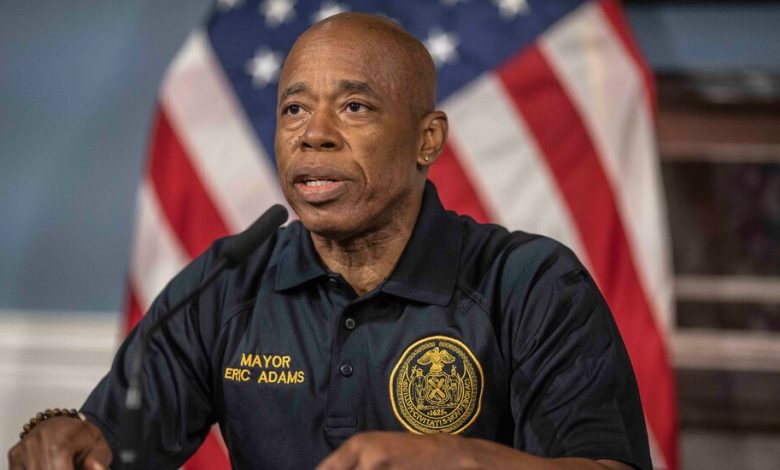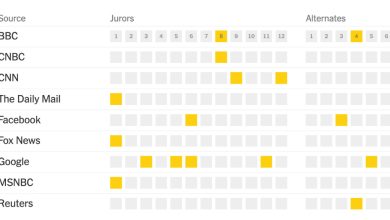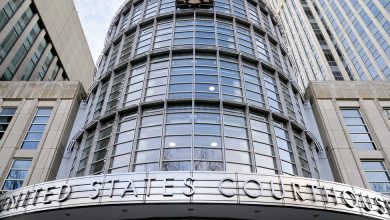New York Has Regained Its Lost Jobs. Why Doesn’t It Feel That Way?

Mayor Eric Adams on Thursday celebrated a milestone in New York’s economic recovery: The city has regained all 946,000 private sector jobs lost during the coronavirus pandemic, more than a year ahead than predicted by the Independent Budget Office, a city watchdog. In total, the city had 4,709,400 public and private jobs in September, the most ever recorded.
In speeches, Mr. Adams pointed to his policies on public safety and sanitation as reasons for the faster than expected turnaround.
But the numbers obscure a more complicated reality about the city’s job market, according to census data and jobs reports. Many new jobs pay less than the ones lost during the pandemic. The typical family is now making less money than before Covid. And the recovery, which has trailed the rest of the nation, has been particularly uneven for Black and Latino workers, who are facing far higher rates of unemployment and poverty.
While the recovery is notable, lingering disparities suggest that the city still has unresolved economic challenges, said James Parrott, the director of economic and fiscal policy at the Center for New York City Affairs at the New School.
“We haven’t recovered in ways that really affect the well-being of most people,” he said.
On Friday, the mayor acknowledged some of the disparities, but also called this his “Aaron Judge year,” referring to the Yankees slugger.
“Is our job done? Of course not, and it won’t be until we have created economic opportunities for every New Yorker,” he said.
Jobs are returning, but mostly in lower-paying positions.
New York’s job recovery has lagged behind other cities in part because the virus struck the city sooner, and vital industries, like hospitality and retail, remained closed longer and lost more jobs.
But the new jobs that offset those losses have often paid much less.
From February 2020 to September 2023, the retail sector shed roughly 39,000 jobs, more than any other industry, according to data from the State Department of Labor. The positions, mostly in clothing and department stores, paid an average of about $62,000 a year.
In the same period, about 66,200 home health aid jobs were added, the most in any industry. They paid an average of $31,000 a year, half of what a retail worker might make. Another 34,000 jobs were added in social services positions, which paid an average of $38,000. The third-fastest growing industry was management consulting, which paid an average $198,000, but only added 14,000 jobs to the economy, Dr. Parrott said.
Many of the retail jobs are unlikely to return, as online shopping and automated kiosks continue to shrink the sector, said Jonathan Bowles, the director of the Center for an Urban Future, a public policy think tank.
More than 70 percent of the more than 300,000 retail jobs in the city are held by Black, Hispanic and Asian workers, many of whom do not have college degrees, according to a June report from the policy group.
The job losses contributed to a growing unemployment gap: 12.2 percent of Black New Yorkers were unemployed in the first quarter of 2023, compared to 1.3 percent of white New Yorkers, the widest disparity this century. The gap narrowed moderately in the spring, when the Black unemployment rate fell to 9.4 percent, Dr. Parrott said.
Wages are down and poverty is up.
For middle-income New Yorkers, stagnant wages and inflation have cut deeper than in any other big city in the country.
From 2019 to 2022, the median household income in New York City fell below $75,000, a nearly 7 percent drop — four times the national rate of decline and the steepest slide among the 10 largest American cities, according to an analysis of census data by the Center for New York City Affairs.
The median household income in Manhattan fell below $96,000, a more than 11 percent drop, while the Bronx, the city’s poorest borough, remained flat at $45,500.
In the same period, more people living on the margins faced financial challenges. Over 18 percent of New Yorkers, or 1.5 million people, were living in poverty, up from 16 percent before the pandemic, the biggest increase among major cities. An individual making less than $15,000 a year, or a family of four making below $30,000, were considered impoverished last year, according to the census. The poverty rates for Black and Latino New Yorkers were roughly twice the rate of white residents.
Now, economic hardship is spurring demand for more public aid. In July, 480,230 New Yorkers received state or federal cash assistance, a 51 percent increase from February 2020, before Covid gripped the city, Dr. Parrott said.
It’s a different recovery at the top.
Wages have increased for some during the pandemic, but mostly for the already affluent, according to Lauren Melodia, deputy economic director at the Center for New York City Affairs.
In an analysis of labor data that split workers into three categories, low-wage earners, who made an average of $40,000 last year, received an average pay bump of $186 annually from 2019 to 2022. The top-tier earners, who made an average of $217,000 last year, received an average pay bump of $5,100 in each of those years, or 27 times more in extra income than low-paid workers.
In September, a month before the mayor’s job recovery announcement, the city marked a different milestone: Three of its boroughs — Manhattan, Brooklyn and the Bronx — were among the counties with the largest income disparities in the country.
In Manhattan, which topped the list, the wealthiest fifth of residents earned an average household income of $545,549, or more than 53 times as much as the bottom 20 percent, who earned an average of $10,259, according to Social Explorer, a demographic data firm.
It was the largest gap recorded since the census began reporting the data in 2006.




